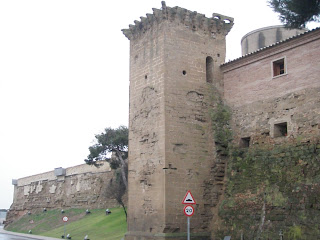26 December 2009 - Spanish hospitality is something of legends. Other cultures value the same, but being latino in the West you know of Spain. And so it was in another spectacularly antiquated and mellow town that I was treated to such forms of this ancient virtue by a most knowledgeable and courteous host.
A good friend to my brother and invariably my mom invited us to her town and home for a tour and lunch. This most magnificently intelligent, wonderfully cultured, and stunningly charismatic woman, whose first name is Pilar, has worked at embassies and in other political capacities throughout her rich career - she has personally addressed post from the King of Spain, military officers, ministers, business owners, journalists, and elected officials. Pilar treated us not only to an superb and surprisingly elemental Spanish lunch, but took her time to show us the utmost in hospitality, personally showing us around much of historic Huesca. This was arguably the best time I spent during my entire visit to Spain - exactly because of Pilar's genuine and unpretentious hospitality, and the depth of knowledge she so willingly imparted.
And so in learning more about this region, I find that the Romans established a colony on the Iberian peninsula starting from c.~200 B.C. Huesca originated as an Iberian community even before then but was named Bolskan and once fully Romanized, was made municipium called Osca by Augustus in 30 B.C. Since then, Huesca has stood at the foot of the mountain range of Guara, just near the Pyrenees Mountains dividing the Iberian peninsula from the rest of Europe. It has continually served as a regional center of knowledge and education, religion, culture and the arts, and commerce. Truly, Huesca is a hidden gem in the midst of Aragon, not to be missed if given the chance.
A good friend to my brother and invariably my mom invited us to her town and home for a tour and lunch. This most magnificently intelligent, wonderfully cultured, and stunningly charismatic woman, whose first name is Pilar, has worked at embassies and in other political capacities throughout her rich career - she has personally addressed post from the King of Spain, military officers, ministers, business owners, journalists, and elected officials. Pilar treated us not only to an superb and surprisingly elemental Spanish lunch, but took her time to show us the utmost in hospitality, personally showing us around much of historic Huesca. This was arguably the best time I spent during my entire visit to Spain - exactly because of Pilar's genuine and unpretentious hospitality, and the depth of knowledge she so willingly imparted.
And so in learning more about this region, I find that the Romans established a colony on the Iberian peninsula starting from c.~200 B.C. Huesca originated as an Iberian community even before then but was named Bolskan and once fully Romanized, was made municipium called Osca by Augustus in 30 B.C. Since then, Huesca has stood at the foot of the mountain range of Guara, just near the Pyrenees Mountains dividing the Iberian peninsula from the rest of Europe. It has continually served as a regional center of knowledge and education, religion, culture and the arts, and commerce. Truly, Huesca is a hidden gem in the midst of Aragon, not to be missed if given the chance.
 Self portrait - through the 'Troll of Stuff', with the antiquity of Huesca in the 'background' mixed with the contemporary.
Self portrait - through the 'Troll of Stuff', with the antiquity of Huesca in the 'background' mixed with the contemporary. My traveling companions awed as I am by this still-running 15th century store off a plaza within the old city wall, to which the ever-energetic Pilar had led us. Note the ceiling masterpiece & the old-school product arrangement.
My traveling companions awed as I am by this still-running 15th century store off a plaza within the old city wall, to which the ever-energetic Pilar had led us. Note the ceiling masterpiece & the old-school product arrangement. Really cool street art. Finding ourselves still within the old city wall, the ancient building facade is real; but the rest...
Really cool street art. Finding ourselves still within the old city wall, the ancient building facade is real; but the rest... "We spend much time dreaming and too little time converting those dreams into reality" - Lucha ("to fight")
"We spend much time dreaming and too little time converting those dreams into reality" - Lucha ("to fight") Built before the Arab domination of Osca - when it was renamed Wasqah - this Roman-era wall fortified the old City. In some places the original stone-brick is clearly passing the test of time...
Built before the Arab domination of Osca - when it was renamed Wasqah - this Roman-era wall fortified the old City. In some places the original stone-brick is clearly passing the test of time... ... and in others it has been remodeled as the old city center has expanded outward. On this side of the city, the wall's entrances are much smaller and were used primarily by workers, servants, & suppliers - note that none of these cars will pass through the portal between the two towers 'recently' converted to homes.
... and in others it has been remodeled as the old city center has expanded outward. On this side of the city, the wall's entrances are much smaller and were used primarily by workers, servants, & suppliers - note that none of these cars will pass through the portal between the two towers 'recently' converted to homes.

































